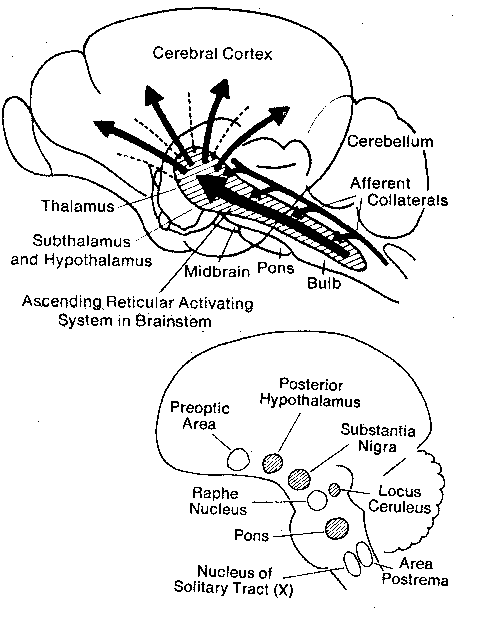Reticular activating system
From Psy3242
Contents |
Overview
[Image:  ]
]
The (ascending) reticular activating system (ARAS) or reticular formation is a structure that sits between the medulla oblongata and midbrain and branches into the brain stem. [1] This system dictates the level of arousal or consciousness for the cortex. Sensory and motor impulses travel in between the cerebral cortex, the thalamus, and the RF; this process influences the degree of alertness (or sleep) in a person (Stirling 8) as well as circadian rhythms, respiration, and heartbeat patterns. [2]
Relation to ADD/ADHD
Since the RAS plays such a large role in motivation, activity level, and a person's ability to pay attention, it makes sense to look for a connection between this area of the brain and the origin of ADD/ADHD [3].
When the RAS is working properly, it serves as balance for all of the other parts of the brain that are also involved in these functions. However, if the RAS is under-stimulating other areas, there can be a distinct drop in the ability to learn, remember, and practice good self-control, which are all symptoms of ADD. The other possible scenario is over-stimulation which can lead to the restlessness and excessive activity associated with ADHD [4].
It's possible that the RAS malfunctions because of a norepinephrine deficiency and this problem is thought to be helped by Ritalin, which increases the level of this chemical in the brain. While this may work well for under-aroused ADD/ADHD, it can caused increased agitation in those who already have an overly-active RAS. The solution to this dilemma is often to prescribe a "norephinephrine antagonist," such as Prozac, which boosts serotonin and inhibitory responses [5].
Motivation and the Yerkes-Dodson Law
The ARAS/RF is directly related to arousal and motivation which are, in turn, related to ability to perform tasks. How well these tasks can be performed is often represented by the inverted U-function (or the Yerkes-Dodson law) which depicts that performance peaks at a certain level of arousal and then deteriorates if that arousal continues to increase because of the associated stress and agitation of being too aroused [6].
Dr. Harris talked to us about this is Stats II last semester when he was describing his early/late day arousal, caffeinated/non-caffeinated performance study. People who were at their peak arousal during a certain time of day performed best at that time (as expected), but their performance deteriorated as they consumed caffeine and actually became overly-aroused. However, caffeine could also be used to increase performance in those who weren't testing during their peak arousal times.
References
Motivation - The inverted-U function
Stirling, John. Introducing Neuropsychology. New York: Psychology Press, 200
